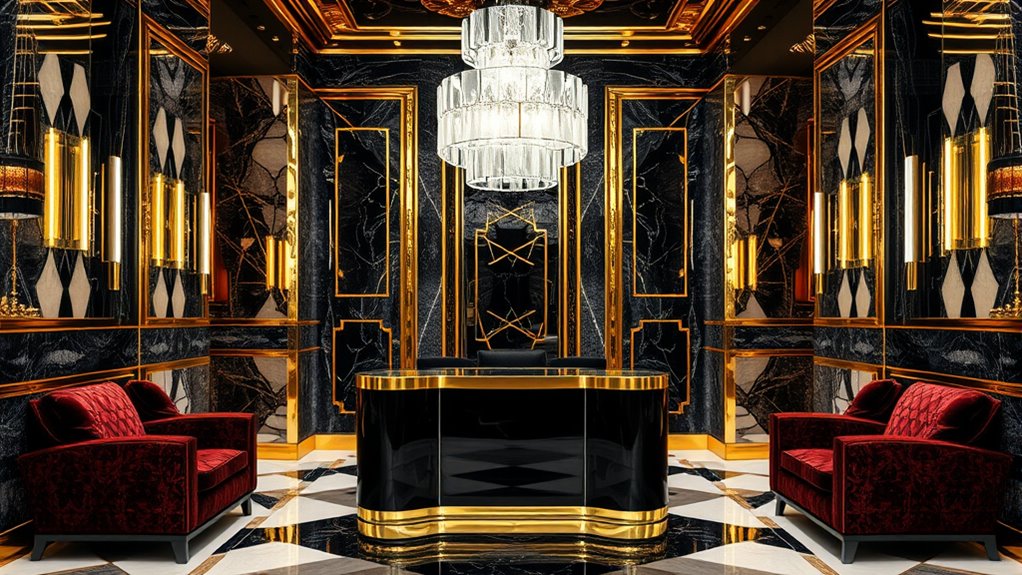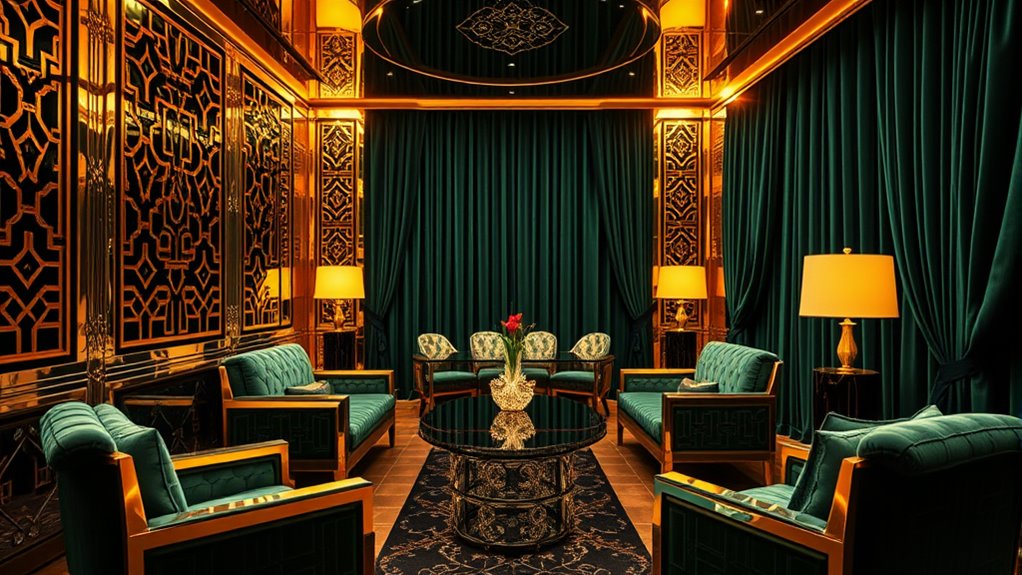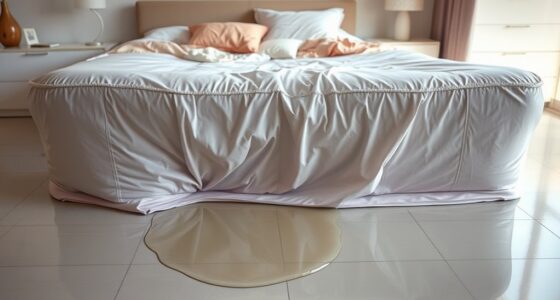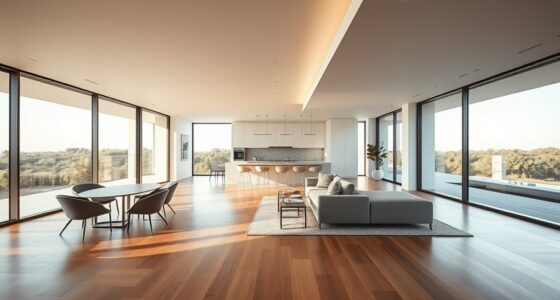Discover how Art Deco from the 1920s combines striking geometric patterns with luxurious materials like diamonds, gold, and platinum. Its sharp angles, zigzags, and architectural motifs symbolize progress, modernity, and innovation. This style reflects a glamorous, sophisticated era marked by craftsmanship and cultural pride. If you want to understand how this iconic movement influenced jewelry and design, exploring further will reveal the fascinating stories behind its timeless appeal.
Key Takeaways
- Art Deco emerged in the 1920s, characterized by bold geometric patterns and luxurious materials.
- Jewelry features sharp angles, zigzags, and sunbursts, reflecting modern architectural motifs.
- Use of diamonds, platinum, and gold emphasizes glamour and craftsmanship.
- Architectural influences, like skyscraper facades, symbolize progress and technological advancement.
- The style embodies elegance, modernity, and a cultural celebration of innovation and luxury.

Art Deco, emerging in the 1920s, revolutionized design with its bold geometric patterns, luxurious materials, and sleek lines. This style isn’t just about aesthetics; it reflects an era of rapid change, glamour, and a desire to break free from tradition. When you think of the luxury jewelry from this period, you’ll notice how it embodies the essence of Art Deco’s emphasis on symmetry and striking shapes. Jewelry designers of the era used precious stones, platinum, and gold to craft pieces that feature sharp angles, zigzags, and stepped forms. These pieces echo the architectural motifs that define the era’s buildings and interiors, creating a seamless connection between fashion and architecture. The influence of architectural motifs in jewelry design isn’t accidental—both draw inspiration from the same love of geometric precision and modernity. You’ll see motifs like chevrons, sunbursts, and stylized floral patterns that mimic the facades of skyscrapers and iconic structures of the time.
In your exploration of Art Deco jewelry, you’ll notice how the use of luxurious materials elevates these geometric designs to a new level of sophistication. The combination of diamonds, onyx, and platinum creates a luxurious feel, while the clean lines and symmetrical arrangements emphasize structure and clarity. This emphasis on luxury wasn’t just about opulence; it was about making a statement. You’re encouraged to see jewelry as an extension of the architectural innovations of the 1920s—modern, bold, and unapologetically glamorous. The geometric motifs aren’t just decorative; they serve as symbols of progress and modernity, capturing the spirit of an era that celebrated technological advancements and cultural shifts. Additionally, the integration of architectural motifs in jewelry reflects the era’s fascination with progress and innovation, making each piece a miniature work of art.
As you explore more deeply, you’ll notice how Art Deco jewelry often integrates architectural motifs like stepped forms and stylized motifs, giving each piece a sense of structure and purpose. These motifs don’t merely decorate; they tell a story of a forward-looking society enthusiastic to embrace new forms and ideas. When you wear or admire these pieces, you’re connecting with a history of innovation and elegance. The jewelry becomes more than adornment; it’s a reflection of a cultural movement that prized craftsmanship, luxury, and modern design. Whether in the form of a statement necklace or a pair of geometric earrings, the influence of architectural motifs and the luxurious materials used in Art Deco jewelry remind you of an era where style, function, and glamour seamlessly converged.
Frequently Asked Questions
How Did Art Deco Influence Modern Interior Design?
Art Deco influences modern interior design by embracing luxury motifs and geometric patterns that create a sense of glamour. You’ll notice these elements in sleek furniture, bold wallpapers, and decorative accents that emphasize symmetry and opulence. This style encourages you to combine rich materials with striking shapes, giving your space a timeless elegance. By incorporating Art Deco’s luxe motifs and geometric designs, you add sophistication and visual interest to any room.
What Materials Were Commonly Used in Art Deco Jewelry?
You’ll notice that Art Deco jewelry often features precious gemstones like emeralds, sapphires, and rubies, which add vibrant color and luxury. Makers also used innovative alloys, blending metals such as platinum and chrome to create sleek, durable pieces with geometric shapes. These materials highlight the era’s emphasis on modernity and glamour, making each piece striking and timeless.
Which Architects Are Most Associated With Art Deco Buildings?
You should look at architects like William Van Alen, famous for the Chrysler Building, and Raymond Hood, known for the Chicago Tribune Tower. They designed streamlined skyscrapers with decorative facades that define the Art Deco style. Their work emphasizes geometric shapes, bold lines, and luxurious details, creating iconic landmarks. These architects truly captured the glamour and modernity of the 1920s, shaping the city skylines with their distinctive, elegant designs.
How Did Art Deco Spread Internationally During the 1920S?
You see art deco spread internationally in the 1920s through exhibitions, magazine features, and the global influence of American culture. As you explore art deco fashion and transportation, you’ll notice how sleek lines and geometric patterns became popular worldwide. Architects and designers adopted these styles, making art deco a symbol of modernity and glamour across cities, from Paris to New York, inspiring a shared aesthetic that transcended borders.
What Is the Legacy of Art Deco in Contemporary Fashion?
You see Art Deco’s legacy in contemporary fashion through sleek geometric patterns and glamorous touches that catch your eye. Designers now blend its elegant lines with sustainable fashion, creating eco-friendly pieces with Art Deco’s signature flair. Digital design trends bring these motifs to life on screens and runways alike, making the timeless glamour both modern and accessible. It’s a vibrant fusion that continues to inspire your style and creativity today.
Conclusion
As you step into the world of Art Deco, you’re transported to an era where every line sparkles with sophistication and every shape whispers glamour. It’s like walking through a jewel box of geometric wonder, where elegance dances with boldness. Embrace this timeless style; let it inspire you to add a touch of shimmering luxury to your own life. Like a dazzling star, Art Deco continues to mesmerize, inviting you to dream in its radiant glow.









